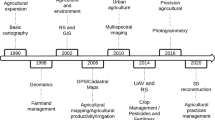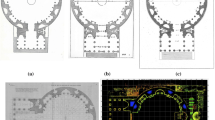Abstract
The aim of this study is to analyze the role of experimental factors in the affine coordinate transformation of cadastral maps using a 23 factorial design. The selected experimental factors and their respective levels include a map scale of 1/500–1/1,000, a number of common points 4 and 20, and the least square and least absolute value adjustment method. The results were statistically analyzed using Student’s t test, analysis of variance (ANOVA), and an F test to define the important experimental factors and their levels. A regression model that considers the significant main and interaction effects is suggested. It was determined that the affine coordinate transformation of cadastral maps was affected by all of the selected experimental factors and the interaction effects between the map scale and number of common points. As results of the experiments, it is determined that the factors levels for the reduced response variable are the 1/500 map scale, 4 common points and the Least Square Adjustment method.

Similar content being viewed by others
References
Demir O., Coruhlu Y.E.: The graphical cadastre problem in Turkey: the case of Trabzon province. Sensors 8, 5560–5575 (2008)
Demir, O.; Coruhlu Y.E.: Determining the property ownership on cadastral works in Turkey. Land use policy (2008). doi:10.1016/j.landusepol.2008.01.011
Demir, O.: Forming base cadastral maps for cadastral information system in orthogonally measured urban areas. PhD thesis, Karadeniz Technical University: Trabzon, Turkey (2000)
http://www.tkgm.gov.tr. Accessed 06 May 2012
Mikhail, E.M.: Observations and Least Squares. IEP-A Dun-Donelley, New York (1976)
Ghilani, D.C.; Wolf, R.P.: Adjustment Computations Spatial Data Analysis. Wiley and Sons, New Jersey (2006)
Basciftci F., Inal C., Basciftci F.: Programming of geodetic transformation methods. Sci. Res. Essays 5(10), 1181–1188 (2010)
Wolf, P.R.; Dewitt, B.A.: Elements of photogrammetry with applications in GIS, 3rd edn. McGraw-Hill, New York (2000)
Gullu M.: Coordinate transformation by radial basis function neural network. Sci. Res. Essays 5(20), 3141–3146 (2010)
Vanicek, P.; Wells, D.E.: The Least Squares Approximation. Department of Geodesy and Geomatics Engineering University of New Brunswick, Canada (1972)
Wang, Y.: A rigorous photogrammetric adjustment algorithm based on co-angularity condition. Int. Arch. Photogramm. Remote Sens. 29(B5), 195–202 (1992)
Edgeworth, F.Y.: On observations relating to several quantities. Hermathena 6, 279–285 (1887)
Edgeworth, F.Y.: On a new method of reducing observations relating to several quantities. Philos. Mag. 25, 184–191 (1888)
Fuchs, H.: Contribution on the adjustment by minimizing the sum of absolute residuals. Manuscr. Geodaet. 7, 151–207 (1982)
Hawley, R.W.; Gallagher, Jr. N.C.: On Edgeworth’s method for minimum absolute error linear regression. Trans. Signal Process. 42(8), 2045–2054 (1994)
Harvey, B.R.: Survey network adjustments by the L1 method. Aust. J. Geod. Photogramm. Surv. 59, 39–52 (1993)
Dodge, Y.: Statistical Data Analysis Based on the L1-Norm and Related Methods. Barika Photography and Productions, New Bedford, MA, USA (2002)
Castillo, E.; Minguez, R.; Castillo, C.; Cofino, A.S.: Dealing with the multiplicity of solutions of the ℓ1 and ℓ∞ regression models. Eur. J. Oper. Res. 188, 460–484 (2008)
Bektas, S.; Sisman, Y.: The comparison of L1 and L2-norm minimization methods. Int. J. Phys. Sci. 5(11), 1721 – 1727 (2010)
Williams, P.H.: Designing Experiments for the Modern Micro Industries. http://www.cepmagazines.org. pp. 58–63 (2006)
Ponnusami, V.; Krithika, V.; Madhuram, R.; Srivastava, S.N.: Biosorption of reactive dye using acid-treated rice husk: Factorial design analysis. J. Hazard. Mater. 142, 397–403 (2007)
Moreb, A.A.; Savsar, M.: Minimizing defects in turfing process using full factorial design. WSEAS Trans. Business Econ. 3(4), 54–57 (2007)
Cestari, A.R.; Vieira, E.F.S.; Mota, J.A.: The removal of an ionic red dye from aqueous solutions using chitosan beads—The role of experimental factors on adsorption using a full factorial design. J. Hazard. Mater. 160, 337–343 (2008)
Jaikumar, V.; Ramamurthi, V.: Statistical analysis and optimization of acid dye biosorption by brewery waste biomass using response surface methodology. Mod. Appl. Sci. 3(4), 71–86 (2009)
Esme, U.; Sagbas, A.; Kahraman, F.: Prediction of surface roughness in wire electrical discharge machining using design of experiments and neural networks. Iran. J. Sci. Technol. (Trans. B-Eng.) 33(B3), 231–240 (2009)
Chan, F.; Calleja, H.: Design strategy to optimize the reliability of grid-conneted PV systems. IEEE T. Ind. Electron. 56(11), 4465–4472 (2009)
Kavak, D.: Removal of boron from aqueous solutions by batch adsorption on calcined alunite using experimental design. J. Hazard. Mater. 163, 308–3014 (2009)
Coruh, S.; Elevli, S.; Senel, G.; Ergun, O.N.: Adsorption of silver from aqueous solution onto fly ash and phosphogypsum using full factorial design. Environ. Prog. Sustain. Energy 30(4), 609–619 (2011)
Mesci, B.; Elevli, S.: Recycling of chromite waste for concrete: Full factorial design approach. Int. J. Environ. Res. 6(1), 145–150 (2012)
Carolina, T.: Evaluating geographic visualization tools and methods: An approach and experiment based upon user tasks. In: Dykes, J.; MacEachren, A.M.; Kraak, M.J. (eds.) Exploring Geovisualization. pp. 645–666 (2005)
Carvajal, F.; Aguera, F.; Aguilar, F.J.; Aguilar, M.A.: Relationship between atmospheric corrections and training-site strategy with respect to accuracy of greenhouse detection process from very high resolution imagery. Int. J. Remote Sens. 31(11), 2977–2994 (2010)
Liptak, M.; Sokol, S.: Reducing the impact of a vertical refraction by a two-regime model. Slovak J. Civil Eng. XIX(2), 21–26 (2011)
George, M.L.; Rowlands, D.; Price, M.; Maxey, J.: Lean Six Sigma Pocket Toolbook. McGraw-Hill, New York (2005)
Navidi, W.: Statistics for Engineers and Scientists. McGraw-Hill, New York (2008)
Montgomery, D.C.; Runger, G.C.; Hubele, N.F.: Engineering Statistics. John Wiley and Sons, New York (2001)
Demir, O.; Uzun, B.; Cete, M.: Turkish cadastral system. Surv. Rev. 40, 54–66 (2008)
Haberler, M.; Kahmen, H.: Detection of landslide block boundaries by means of an affine coordinate transformation. In: Proceedings 11th FIG Symposium on Deformation Measurements, Santorini, Greece (2003)
Vieira, C.; Marotta, G.; Rodrigues, D.; Andrade, R.: Visualizing positional uncertainties of geometric corrected remote sensing images. In: Proceedings of the 8th International Symposium on Spatial Accuracy Assessment in Natural Resources and Environmental Sciences. pp. 327–334 (2008)
Kwon, J.H.; Bae, T.S.; Choi, Y.S.; Lee, D.C.; Lee, Y.W.: Geodetic datum transformation to the global geocentric datum for seas and islands around Korea. J. Geosci. 9(4), 353–361 (2005)
Ismail, A.A.; El-Midany, A.A.; Ibrahim, I.A.; Matsunaga, H.: Heavy metal removal using SiO2-TiO2 binary oxide: Experimental design approach. Adsorption 14, 21–29 (2008)
Gygi, C.; Decarlo, N.; Williams, B.: Six Sigma for Dummies. Wiley, Indiana (2005)
Koch, K.R: Parameter Estimation and Hypothesis Testing in Linear Models. Springer, Berlin (1999)
Mosteller, F.; Rulon, P.J.; Harris, T.E.: Regression using minimum absolute deviations. Am. Stat. 4(1), 14–15 (1950)
Author information
Authors and Affiliations
Corresponding author
Rights and permissions
About this article
Cite this article
Sisman, Y. A Full-Factorial Design Approach for Coordinate Transformation. Arab J Sci Eng 39, 227–235 (2014). https://doi.org/10.1007/s13369-013-0864-y
Received:
Accepted:
Published:
Issue Date:
DOI: https://doi.org/10.1007/s13369-013-0864-y




